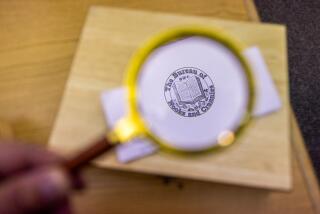Here’s a Pin-Up Bunny Who’s a Real Pussycat
- Share via
Two local women are making money off a cat’s good looks, but they want it known they’re not guilty of exploiting their model. “We have the money in a trust fund for her,” Lauren Wood said of her black-and-white kitty, named The Bunny. “She’ll be rich when she’s 21.”
Wood, a singer with five albums on the Warner Bros. label, and photographer Sherry Rayn Barnett, began taking pictures of The Bunny one day and found that the cat was willing to be put into ridiculous poses, wearing frivolous outfits and hats. “She lets me bend her in any position--once,” Wood said.
They turned the photos of Bunny into a line of greeting cards which are being nationally distributed. Locally the cards are available at Aahs and the Card Factory stores, as well as Fred Segal, Nordstrom and other outlets. While there are a lot of business people getting rich off cats in this era of unprecedented feline popularity, Barnett said their Cat Tricks card line is different because they all feature a single, readily identifiable model.
Currently selling well is a Christmas card displaying The Bunny wearing touristy sunglasses and a Santa suit. The Bunny’s most famous trick, Barnett said, is her ability to lay flat on her back with her paws in the air, stick-em-up fashion. Wood and Barnett have milked this pose for several cards including a get-well card, with a toy nurse hovering over the prostrate Bunny, and a pool party card in which the cat is made to look like she’s doing the backstroke.
The Cat Tricks gold mine has not totally taken over the card creators’ lives. Wood still plays in a band, called Bad Art. And Barnett still finds time for her photography specializing, she said, “in entertainment . . . and cats.”
A Special Catalogue
Opening the front door of his Huntington Beach condominium is a chore for Richard Crandall. He is a dwarf, so the doorknob is not at the right height; and his grip is weakened, making the task even more difficult. (Like many short statured people, Crandall suffers some mobility impairment.)
There are a number of gadgets and devices that could have made it easier for Crandall to work his doorknob--as well as helping him perform other household tasks--if he had known about them. The trouble is that such aids normally are marketed only through hospitals and institutions.
“Most of us (little people) do without special devices, as a matter of fact,” Crandall said.
Now Crandall is compiling a catalogue of such items specially geared to the needs of short people. To be called, “Short Stature Adaptive Aid Catalogue,” the book should be available early next year. It’s a project of the Short Stature Foundation and Information Center which Crandall founded last year after his 17-year-old daughter, Michelle--also a dwarf--committed suicide partly because of distress at feeling she was different from other people.
With the foundation and now the catalogue, Crandall hopes to tackle a major problem for short people: employment. Once the mail-order adaptive aid catalogue is complete, Crandall’s foundation will hire short statured people to process, fill and ship orders. (The foundation is currently looking for people to help with the project. The phone number is (714) 964-9388.)
All Mapped Out At Last
If someone were assigned to update a map of, say, Santa Monica, first drafted in 1913, he or she might as well scrap the relic and start over. But when N. King Huber of the U. S. Geological Survey was given a similar task--to complete a map of the Yosemite Valley that had first been scouted during the years 1913 to 1916--all he had to do was modernize a term or two. “Rocks don’t change much,” said Huber, who lives in Mountain View.
The just-released work is the first complete geologic map of Yosemite Valley. It’s a colorful, even gaudy rendering of the Valley, which will be valuable to park interpreters, as well as lay naturalists. The final product represents a collaboration across the decades by Frank Calkins, the geologist who did the original field work, and Huber, who has surveyed in the Sierra backcountry for 30 years.
“Frank Calkins was a consummate perfectionist and he was just never satisfied with it (the map),” said Huber. Calkins died in 1974 at the age of 96, after working for 68 years for the U. S. Geological Survey. His Yosemite project was resurrected briefly in the ‘60s, then dragged out again last year and assigned to Huber when the Survey decided it really was time to complete what had been begun 72 years ago.
A True Benchmark
The benches along Ocean Front Walk in Venice may simply be places to rest bodies tired from roller skating for some people, but to anthropologist and author Barbara Myerhoff they represented the last link to community for the old people of the Israel Levin Senior Center.
In a book and later a film called “Number Our Days,” Myerhoff described “bench behavior” at length, explaining how the benches were used as a meeting place, story-telling site, and station that anchored the seniors to a changing world.
Myerhoff died of cancer last January at age 48. In her memory, an acquaintance, Lauren Deutsch, has been raising funds to have a sturdy new bench replace one of the battered benches outside the Israel Levin Center. A plaque to be imbedded in the bench has been inscribed with this quote from the book: “Teach us to number our days, that we may get us a heart of wisdom.” The double-sided bench is under construction and will be installed in a dedication ceremony that has yet to be scheduled.
More to Read
Sign up for Essential California
The most important California stories and recommendations in your inbox every morning.
You may occasionally receive promotional content from the Los Angeles Times.













